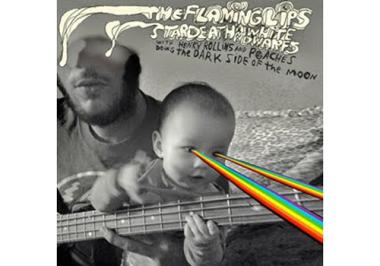Rafter
Animal Feelings
(Asthmatic Kitty Records)
Make no mistake, Rafter Roberts is feeling sexy. He’s also here to start the party, and here he does just that. Animal Feelings is an experimental, eclectic pop album that seeks to excite as well as intrigue. With influences from Justin Timberlake to Nintendo music composer Koji Kondo, the result is an album that’s impossible to pigeonhole. Opening track “No Fucking Around” gives listeners a taste of what they’re in for with distorted auto-tune vocals, hard-hitting beats and an almost R&B vibe. From there, anything goes. Hand claps, mbira, and ’80s-style drum sounds all make appearances, as do various synthesizer squawks and electronic blips. Lyrically, the record borders on mindless and repetitive. Hearing the same chorus over and over is grating at first, but it doesn’t matter: you’ll still be singing along in the end. —Michael Cimaomo
The Flaming Lips & Star Death and White Dwarfs
Dark Side of the Moon
(Warner Bros.)
The Flaming Lips create such a retro-futurism on this tribute with analog synths, pedals, feedback and vocal processors that the resulting flavor is bizarre and somewhat dystopian. The recording sounds like it could be a soundtrack for an apocalyptic Terry Gilliam film a la Brazil or 12 Monkeys, but it also sounds like it was thrown together in someone’s basement. If Tom Waits used primitive electronic instruments to make his music instead of his usual (even more primitive) tribal percussion, metal objects and acoustic pianos, one might expect a product much like this. Henry Rollins and Peaches make appropriate contributions according to their particular talents, and the gestalt of the thing is very washy—there are constant sonic pastiches in the background that consist of either blowing-wind sounds or Beck-inspired industrial or groove loops. —Tom Sturm
The Suitcase Junket
Sever and Lift
(independent)
Sever and Lift begins with a sort of triumphant strangeness cobbled together by flailing acoustic guitar, clanging percussion and vocal (?) tones that land somewhere between Tuvaan-style throat singing, a sitar and a whistle. However that happened, it’s very cool, especially considering the album was recorded live and without overdubs, according to the liner notes. As if that weren’t enough, there’s only one musician credited with making all these live sounds: Matt Lorenz. He appears to be making all that noise with a suitcase, a high hat, a gas can, a guitar and voice. Lorenz’ songs offer strongly sung, compelling melodies, a continual sense of imminent collapse, and a talented use of every end of the limited sonic spectrum available to a solo performer. He even employs an often under-utilized tool—silence—to arrange his strange-attractor music. This is a grandly executed, highly individual effort from start to finish. —James Heflin



